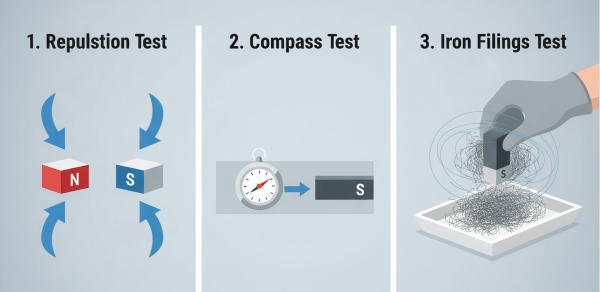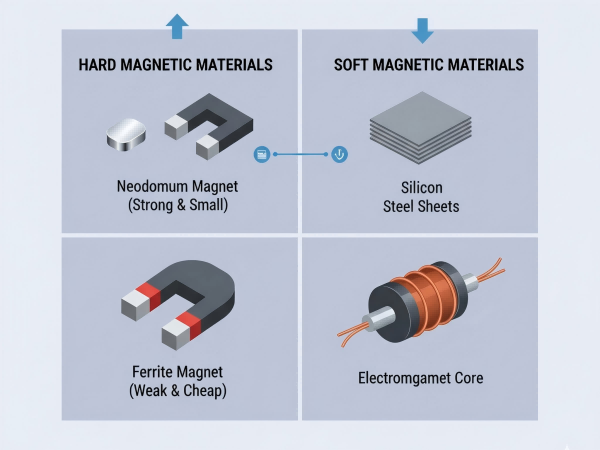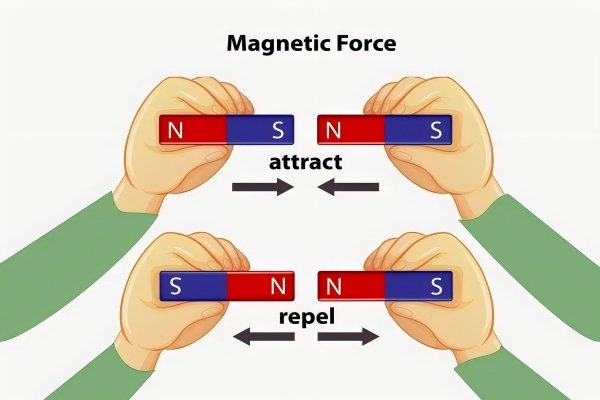You can distinguish a magnet from a non-magnetized magnetic material by checking for repulsion. A real magnet has two poles and can both attract and repel another magnet. When like poles meet, they push away from each other.
A non-magnetized magnetic material may still be attracted to a magnet, but it cannot repel, because its internal magnetic domains are not aligned into permanent poles.
To confirm, you can use simple tools like iron filings, a compass, or a gauss meter. These help reveal whether the object generates its own magnetic field or simply reacts to one.
So This basic idea is the foundation for how will you distinguish magnets from non magnetized magnetic materials anywhere you work.
Table of Contents
4 Easy Hands-On Tests

These practical methods work whether you’re in a factory or classroom. They help you spot magnetization fast and correctly. Each test has its own purpose, from definitive proof to quick checking.
Method 1: Repulsion Test
This is the best way to confirm if something is a permanent magnet. It’s clear and trustworthy.
You need one known magnet. A simple bar magnet with marked poles works great. Even a strong fridge magnet will do the job.
First, put the test object on a flat, smooth surface. This reduces friction.
Bring one pole of your known magnet close to the test object. Watch for any pulling attraction.
Next, flip the known magnet around. Bring its other pole close to the same spot on the test object.
If you feel pulling on both sides when you flip your known magnet, the object is unmagnetized magnetic material like steel.
If you feel pulling on one side and clear pushing on the other, the object is a permanent magnet. That springy, pushing force of repulsion is unmistakable. It proves there’s a permanent magnetic field.
Method 2: Compass Test
This method works great for finding even weak magnetic fields. These might be too weak for a clear repulsion test.
You need a simple magnetic compass.
Put the compass on a level surface away from other magnetic fields or large metal objects. Wait for the needle to settle and point to magnetic North.
Slowly bring the test object near the compass side. Be careful not to touch it.
If the compass needle moves, spins, or points toward the object, the object is magnetized. How much it moves shows how strong the magnetic field is.
If the needle doesn’t move at all, the object is either unmagnetized magnetic material or non-magnetic material. This test can’t tell those two apart. But it reliably shows if a magnetic field exists.
Method 3: Iron Filings Test
This classic classroom demo gives you a quick, visual way to check for magnetism. It only tests for attraction.
You need iron filings, small paperclips, or other small, lightweight iron objects.
Bring the test object close to a pile of iron filings or a single paperclip.
If the filings or paperclips jump to and stick to the object, it’s magnetized. If the filings form a pattern showing distinct poles, you have strong proof of a permanent magnet.
But this test has an important limit. It can’t definitively tell a permanent magnet from temporarily magnetized soft iron. It only confirms that a magnetic field exists right now.
Summary Table: Choosing Methods
Test Method | Reliability | Equipment Needed | Best For |
Repulsion Test | Definitive | Known Magnet | Proving an object is a permanent magnet. |
Compass Test | High | Magnetic Compass | Detecting weak or residual magnetic fields. |
Iron Filings Test | Basic | Iron Filings/Paperclips | Quick visual check for attraction. |
The Science Behind It

Understanding the difference between a magnet and magnetic material means looking at the microscopic level. The key difference is in the internal structure and alignment of magnetic domains.
What Makes Something “Magnetic”?
Materials that respond strongly to magnetic fields are called ferromagnetic. This group mainly includes iron, nickel, cobalt, and their alloys.
These elements have a special atomic structure. Their electrons create tiny, atomic-scale magnetic moments. You can learn more about the physics from educational resources like the Khan Academy’s explanation of ferromagnetism.
Understanding Magnetic Domains
Picture a magnetic material made up of billions of microscopic regions called magnetic domains.
Each domain is like a tiny, powerful magnet with its own north and south pole. Think of them as an army of tiny soldiers, each carrying a compass.
Unmagnetized Magnetic Materials
In a regular piece of iron or steel – an unmagnetized magnetic material – these domains exist in chaos.
The “soldiers” point in random directions. Their individual magnetic fields are scattered randomly, so they cancel each other out on a large scale.
The material as a whole has no net external magnetic field. It gets attracted to a magnet, but it doesn’t act like a magnet itself.
Permanent Magnets: Creating Order
To make a permanent magnet, the material must face a very strong external magnetic field during manufacturing.
This powerful field forces the “soldiers,” or magnetic domains, to rotate and line up in the same direction.
In hard magnetic materials, this alignment gets locked in place. The domains stay aligned even after the external magnetizing field is removed.
This collective, unified alignment of billions of domains creates one large, strong, and permanent external magnetic field. This defines a permanent magnet.
Professional Quality Control Guide

For engineers, procurement managers, and quality control inspectors, just knowing the difference isn’t enough. Professional inspection is essential to prevent costly failures.
Why Professional QC Matters
Getting materials wrong can have serious consequences. An unmagnetized component in a sensor or motor causes immediate product failure.
In food or pharmaceutical processing, an unmagnetized separator rod fails to catch iron contaminants. This creates a safety risk.
Getting a batch of unmagnetized steel when you ordered permanent magnets can stop an entire assembly line. This leads to major financial losses and project delays.
A Standard Inspection Process
Setting up a Standard Operating Procedure (SOP) for incoming magnetic materials is a best practice.
- Documentation Review: Always start by checking the paperwork. Confirm that material certifications and purchase order specs match. Does the spec call for a magnetized part or unmagnetized raw material?
- Visual Inspection: Look for identifying marks, part numbers, or labels. Check for physical damage like chips or cracks, which can affect magnetic performance.
- Initial Screening: Use batch sampling. Pick a representative number of parts from the shipment and do the simple Repulsion Test with a calibrated reference magnet. This quickly sorts batches into “magnetized” and “potentially unmagnetized.”
- Quantitative Measurement: For critical applications, a simple yes/no isn’t enough. You need data. This requires professional measurement tools to verify that magnetic properties meet specified tolerances.
- Reporting and Labeling: Document all findings. Clearly label batches after inspection as “Verified Magnetized,” “Verified Unmagnetized,” or “Quarantined for Further Testing.”
Essential Measurement Tools
Beyond simple checks, professional quality control uses precise instruments to measure magnetic fields.
Gaussmeters, also called Teslameters, are the most common tools. They measure magnetic field strength, or flux density, at a specific point on the magnet’s surface. This answers: “How strong is this magnet right here?”
Fluxmeters work with a surrounding coil (a Helmholtz coil) to measure total magnetic flux, or total magnetic output, of the entire magnet. This answers: “What is the total power of this magnet?”
These instruments measure in units of Gauss or Tesla, where 1 Tesla equals 10,000 Gauss. For more information on these tools, industry publications like Magnetics Magazine provide excellent resources.
Understanding Key Specifications
When buying magnets, you’ll see several key specs on a data sheet. Understanding them is crucial for purchasing managers.
Specification | What it Means in Simple Terms | Why it Matters for Your Application |
Residual Flux Density (Br) | How strong the magnetic field is on its own. | Determines the surface field strength and attractive force. |
Coercivity (Hc) | How resistant the magnet is to being demagnetized. | Critical for applications with high temperatures or opposing fields. |
Max Energy Product (BH)max | The overall “performance” or energy density. | A key indicator of a magnet’s total power and efficiency. |
For a deeper dive into how these specifications apply to the most powerful magnets, explore our range of Neodymium Magnets.
Common Magnetic Materials
The term magnetic materials covers a wide range of alloys, each designed for a specific purpose. They fall into “hard” or “soft” categories.
Hard Magnetic Materials
These materials make permanent magnets. They have high coercivity, meaning they’re hard to magnetize but keep their magnetism strongly.
Neodymium magnets (NdFeB) are the powerhouses of the permanent magnet world. They offer the highest strength-to-size ratio. This makes them essential for high-performance motors, sensors, hard drives, and modern electronics. Their main drawbacks are lower operating temperature and susceptibility to corrosion.
Ferrite magnets, or ceramic magnets, are the workhorses. Made from strontium carbonate and iron oxide, they’re extremely cost-effective. They have excellent resistance to corrosion and demagnetization. Their balance of cost and performance makes Ferrite Magnets popular for speakers, refrigerator magnets, and many DC motors.
Samarium Cobalt (SmCo) and Alnico magnets are specialists. They offer superior performance at high temperatures where neodymium magnets would fail. This makes them vital for military, aerospace, and demanding industrial applications. For detailed material properties, resources like Matweb provide extensive databases.
Soft Magnetic Materials
Unlike hard magnets, soft magnetic materials aren’t designed to be permanent magnets. They have low coercivity, meaning they’re easily magnetized and demagnetized.
Their purpose is to enhance and channel magnetic flux. They act as a pathway for magnetic fields.
Common examples include silicon steel used in transformer cores and soft iron used as the core in electromagnets. They become powerful magnets when current flows through a surrounding coil. But they lose almost all their magnetism when the current turns off.
From Recognition to Decision
Learning to distinguish between magnets and magnetic materials is the first step. Next is making the right choice for your project.
Key Points Summary
Remember that repulsion is the only definitive test for a permanent magnet. The basic difference lies in the internal alignment of magnetic domains.
For professional applications, a simple check isn’t enough. A solid QC process involves both qualitative screening and quantitative measurement with tools like Gaussmeters.
Your Next Step
Now that you know how will you distinguish magnets from non magnetized magnetic materials, the next challenge is sourcing the correct material. You need the right properties, consistently and reliably.
Mistakes in material selection, magnetization level, or quality control can lead to costly product failures and production downtime. Partnering with a magnetics expert isn’t a cost – it’s an investment in reliability and performance. As a leading authority, the IEEE Magnetics Society promotes excellence in the field, a standard we uphold. The foundational science, often explored in journals like Nature, drives the innovations we provide.
Whether you need high-strength custom magnets, precision magnetic assemblies, or expert advice on selecting the right material for your project, our team is ready to help.
Contact Us today to discuss your requirements with a magnetics specialist.
We are a manufacturer specializing in the research and development of magnets with years of industry experience. Our product offerings include NdFeB magnets, ferrite magnets, and custom magnetic components. Our goal is to provide high-quality magnetic solutions to customers worldwide, and we also offer OEM/ODM customization services. If you have any questions about magnets or custom applications, please feel free to contact our team of experts.

cnmmagnet
contact us
Facebook
Twitter
LinkedIn
WhatsApp
